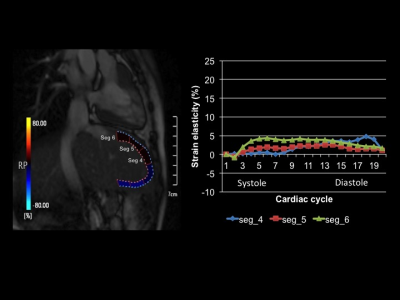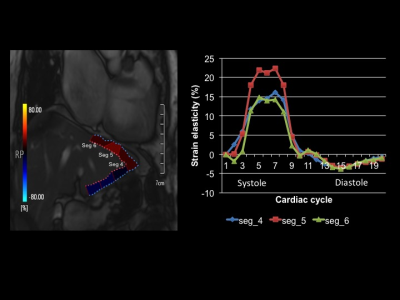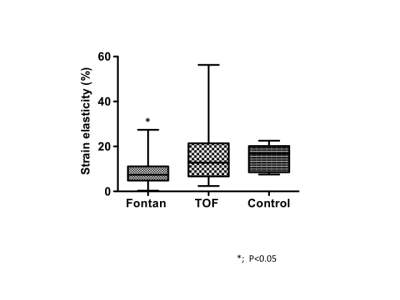4776
Strain elastography using a feature- tracking of cine cardiac magnetic resonance imaging: assessment of liver fibrosis in Fontan patients and tetralogy of Fallot1Department of Diagnostic imaging & Nuclear Medicine, Tokyo Women's Medical University, Tokyo, Japan, 2Department of Radiological service, Tokyo Women's Medical University, Tokyo, Japan, 3Department of Pediatric Cardiology, Tokyo Women's Medical University, Tokyo, Japan, 4Toshiba Medical Systems Corporation, Tochigi, Japan, 5Philips Electronics Japan, Tokyo, Japan
Synopsis
We propose a new strain elastography to quantify hepatic fibrosis using feature tracking method of cardiac cine MRI, and investigate the strain elasticity in long-term post-operative patients after Fontan and intracardiac repair (ICR) for tetralogy of Fallot (TOF). The strain elasticity was lower for Fontan patients than that for TOF patients and controls, suggesting that liver fibrosis progresses after Fontan operation. The strain elastography using feature tracking method of cardiac cine MRI is a noninvasive new method for prediction of liver fibrosis.
Introduction
Fontan operation is the standard treatment for patients with congenital single-heart disease.1-3 Although early postoperative survival rates have improved,4-7 long-term morbidity and mortality rates of patients after Fontan operation remain worse compared with those of patients with other types of congenital heart disease (CHD).7 One of the causes of poor prognosis is hepatic complications, such as that due to hepatic congestion and fibrosis, which is increased owing to the central venous pressure in Fontan circulation. However, liver complications are difficult to predict because the severity of liver dysfunction is not parallel to the basis of serum chemical testing.8 Even biopsies may not indicate the extent of liver dysfunction and have not shown correlation with clinical outcome.9 Therefore, non-invasive techniques for the prediction of liver fibrosis are required.
Here, we propose a new strain elastography technique to quantify hepatic fibrosis using the feature tracking method of cardiac cine magnetic resonance imaging (MRI) and investigate strain elasticity in long-term postoperative patients after Fontan and intracardiac repair (ICR) for tetralogy of Fallot (TOF).
Methods
Patient population
The ethical review board of our institution approved the study, and written informed consent was obtained from each subject. Cardiac cine MRI data of 20 patients who underwent Fontan operation (mean age, 21.4 years), 15 patients with TOF (mean age, 32.4 years), and 10 healthy controls (mean age, 51.6 years) were analyzed.
Cardiac MRI
Cardiac cine MRI of the short-axis left ventricle in the two- and four-chamber views was performed using a cine- balanced turbo field- echo sequence at 1.5 Teslar MRI scanner (Gyroscan ACS- NT, Philips Electronics). Cardiac cine images in which the ventricle or atrium was closest to the liver and the liver moved the most by heartbeat were selected. A depth of 1 cm from the liver surface under the diaphragm was set as a region of interest, and strain in the craniocaudal direction was calculated using the feature tracking method (Vitrea, Toshiba Medical Systems). Then, the maximum absolute value of the strain throughout a cardiac cycle was defined as strain elasticity and was used as an indicator of fibrosis.
Statistical analysis
Strain elasticity was compared between the two groups of patients with Fontan and TOF, and the controls by using the Mann-Whitney U test.
Results
The strain elasticity of the patients who underwent Fontan operation was significantly lower than that of the patients with TOF and the controls (Fontan, 8.5% ± 6.3%; TOF, 20.1% ± 22.2%; control, 15.0% ± 5.8%). No significant difference was found between the patients with TOF and the controls.Discussion
Hepatic complications have been increasingly reported in the late phase after Fontan operation. However, no standard diagnostic tool has been established for detecting hepatic fibrosis in patients undergoing Fontan operation. Our initial experience of a new strain elastography technique using feature-tracking cardiac cine MRI demonstrates that it is a helpful tool for assessing liver fibrosis in patients who underwent Fontan operation. In addition, this non-invasive method enables retrospective analysis using standard cardiac cine imaging. Therefore, it does not need a special sequence for scanning and is easy to use in clinical practice.Conclusion
Strain elasticity was lower for the patients undergoing Fontan operation than for the patients with TOF and the controls, suggesting that liver fibrosis progresses after Fontan operation. Strain elastography using the feature-tracking method in cardiac cine MRI is a non-invasive new method for predicting liver fibrosis.Acknowledgements
The work was supported by the Japan Society for the Promotion of Science (JSPS) KAKENHI(16K10321)References
1. Fontan F, Baudet E. Surgical repair of tricuspid atresia. Thorax. 1971;26:240-248.
2. Kreutzer G, Galindez E, Bono H, et al. An operation for the correction of tricuspid atresia. J Thorac Cardiovasc Surg. 1973;66:613-621.
3. Gates RN, Laks H, Drinkwater DC Jr, et al. The Fontan procedure in adults. Ann Thorac Surg. 1997;63(4):1085-1090.
4. Wolff D, van Melle JP, Ebels T, et al. Trends in mortality (1975–2011) after one- and two-stage Fontan surgery, including bidirectional Glenn through Fontan completion. Eur J Cardiothorac Surg. 2014;45:602-609.
5. Mahle WT, Spray TL, Wernovsky G, et al. Survival after reconstructive surgery for hypoplastic left heart syndrome: a 15-year experience from a single institution. Circulation. 2000;102(19 Suppl 3):III136-III141.
6. Tweddell JS, Ghanayem NS, Mussatto KA, et al. Mixed venous oxygen saturation monitoring after stage 1 palliation for hypoplastic left heart syndrome. Ann Thorac Surg. 2007;84(4):1301-1310; discussion 1310-1311.
7. Hideo Ohuchi. Adult patients with Fontan circulation: What we know and how to manage adults with Fontan circulation? J Cardiol. 2016 Sep;68(3):181-9.
8. Furukawa T, Akimoto K, Ohtsuki M, et al. Non-invasive assessment of liver fibrosis in patients after the Fontan operation. Pediatr Int. 2011;53(6):980-984.
9. Guha IN, Bokhandi S, Ahmad Z, et al. Structural and functional uncoupling of liver performance in the Fontan circulation. Int J Cardiol. 2011;164:77-81.
Figures

15 year old male after 13 years of the Fontan procedure.
A depth of 1 cm from the liver surface under the diaphragm was set as a region of interest, and strain in the craniocaudal direction was calculated using the feature tracking method. Then, the maximum absolute value (4.8 % ) of the strain throughout a cardiac cycle was defined as strain elasticity and was used as an indicator of fibrosis.

54 year old male after 42 years of ICR for TOF.
A depth of 1 cm from the liver surface under the diaphragm was set as a region of interest, and strain in the craniocaudal direction was calculated using the feature tracking method. Then, the maximum absolute value (22.3 % ) of the strain throughout a cardiac cycle was defined as strain elasticity and was used as an indicator of fibrosis.

Comparison of strain elasticity among patient with Fontan and TOF, and controls.
The strain elasticity of the patients who underwent Fontan operation was significantly lower than that of the patients with TOF and the controls (Fontan, 8.5% ± 6.3%; TOF, 20.1% ± 22.2%; control, 15.0% ± 5.8%). No significant difference was found between the patients with TOF and the controls.